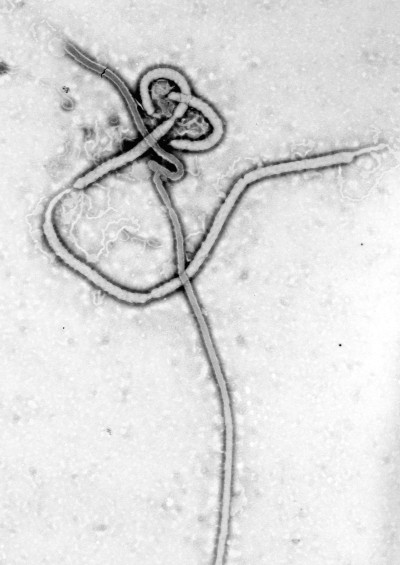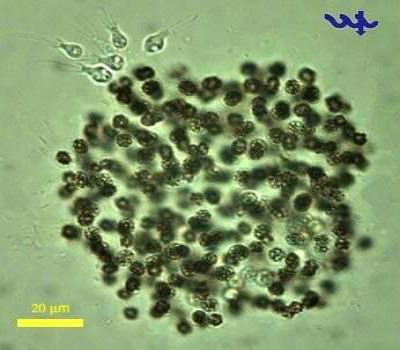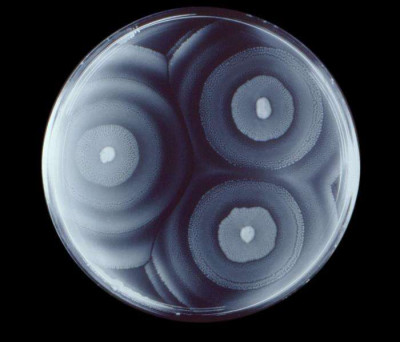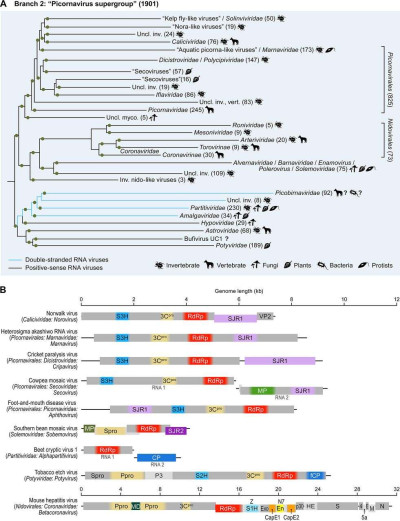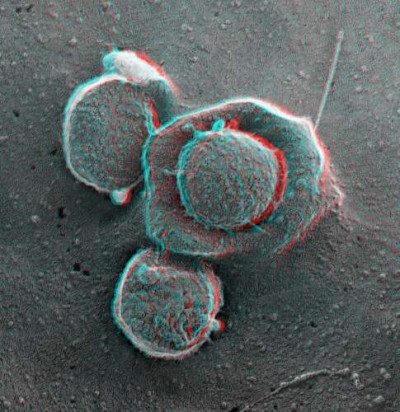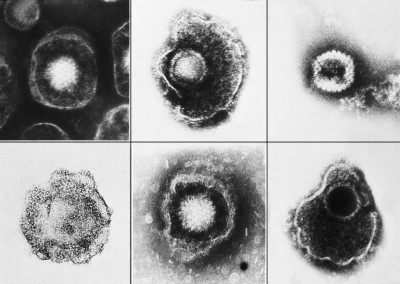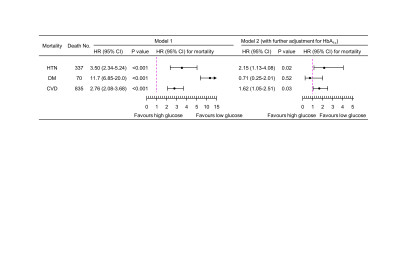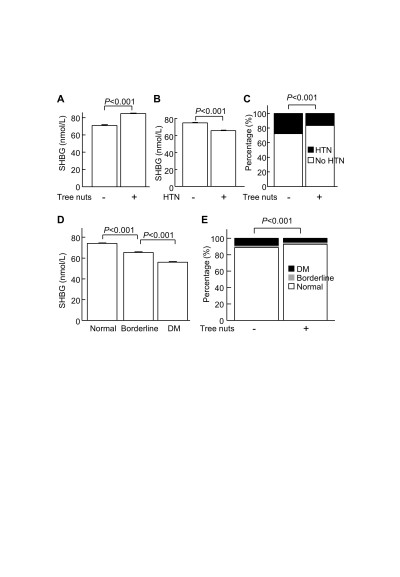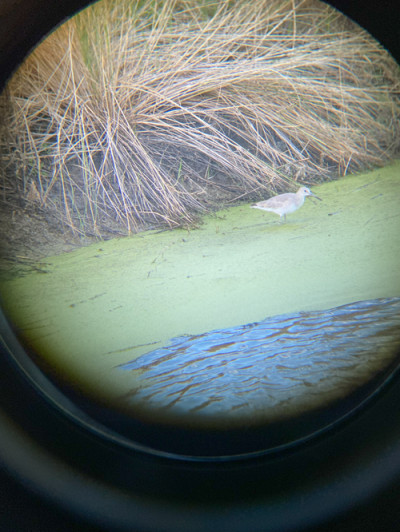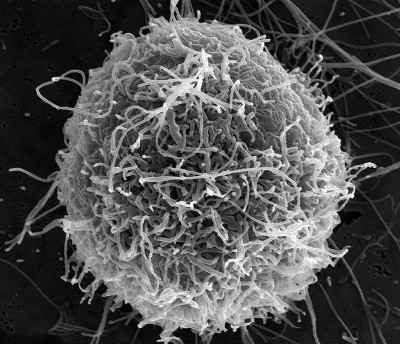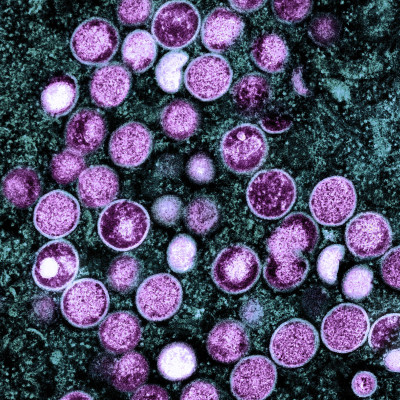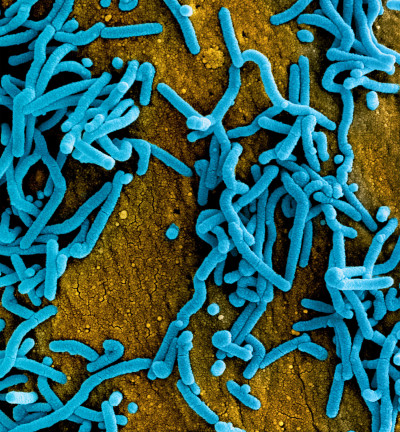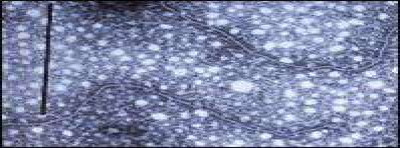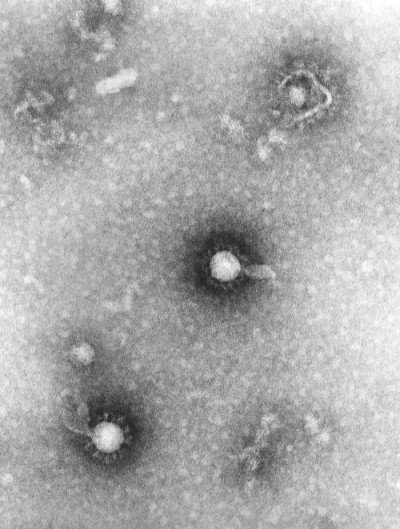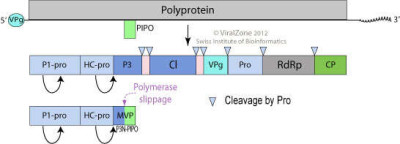Transmission Electron Micrograph of the Ebola Virus.
Wikimedia Commons, CDC/ Dr. Frederick A. Murphy
03 Apr 2024
Schematic representation of the genome organization of Marburg virus. Courtesy of Jiro Wada, IRF-Frederick.
Wikimedia Commons, Jens H. Kuhn, Gaya K. Amarasinghe, Christopher F. Basler, Sina Bavari4, Alexander Bukreyev, Kartik Chandran, Ian Crozier, Olga Dolnik, John M. Dye, Pierre B. H. Formenty, Anthony Griffiths, Roger Hewson, Gary P. Kobinger, E
10 Apr 2024
Microcystis flos-aquae (Cyanobacteria, Chroococcales) is a together with Microcystis aeruginosa are common in Lake Kinneret throughout the year, occasionally forming blooms with surface scums in winter or spring. The individual cells in a M. flos-aquae colony are 3-4 um in diameter, the colony is spherical or lens-shaped, with varying degree of spacing between cells within a colony. The dark spots clearly showing in the individual cells in this picture are due to the reflection of light from the gas vesicles. A bunch of choanoflagellates are attached at the upper left side of the colony.
Alla Alster, Tamar Zohary, micro*scope
22 Jul 2024
This photograph depicts a Petri dish culture plate, which had contained a trypticase soy agar growth medium, that had been inoculated with Proteus mirabilis bacteria, and subsequently gave rise to this colonial growth pattern referred to the Dienes reaction.
Dr. John J. Farmer, CDC public health image library, Wikimedia Commons
03 Sep 2024
Branch 2 of the RNA virus RNA-dependent RNA polymerases (RdRps): “picornavirus supergroup” of the +RNA viruses expanded to include nidoviruses and two groups of dsRNA viruses, partitiviruses, and picobirnaviruses. (A) Phylogenetic tree of the virus RdRps showing ICTV accepted virus taxa and other major groups of viruses. Approximate numbers of distinct virus RdRps present in each branch are shown in parentheses. Symbols to the right of the parentheses summarize the presumed virus host spectrum of a lineage. Green dots represent well-supported (≥0.7) branches. Inv., viruses of invertebrates (many found in holobionts, making host assignment uncertain); myco., mycoviruses; Uncl., unclassified; vert., vertebrate. (B) Genome maps of a representative set of branch 2 viruses (drawn to scale) showing color-coded major conserved domains. Where a conserved domain comprises only a part of the larger protein, the rest of this protein is shown in light gray. The locations of such domains are approximated (indicated by fuzzy boundaries). 3Cpro, 3C chymotrypsin-like protease; CP, capsid protein; E, envelope protein; En, nidoviral uridylate-specific endoribonuclease (NendoU); Exo, 3′-to-5′ exoribonuclease domain; fCP, capsid protein forming filamentous virions; M, membrane protein; MD, macrodomain; MP, movement protein; MT, ribose-2-O-methyltransferase domain; N, nucleocapsid protein; N7, guanine-N7-methyltransferase; Ppro, papain-like protease; SJR1 and SJR2, single jelly-roll capsid proteins of type 1 and type 2; spike, spike protein; S1H, superfamily 1 helicase; S2H, superfamily 2 helicase; S3H, superfamily 3 helicase; VP2, virion protein 2; Z, Zn-finger domain; Spro, serine protease; P3, protein 3. Distinct hues of same color (e.g., green for MPs) are used to indicate cases where proteins that share analogous function are not homologous [1].
Wikimedia Commons, Yuri I. Wolf, Darius Kazlauskas, Jaime Iranzo, Adriana Lucía-Sanz, Jens H. Kuhn, Mart Krupovic, Valerian V. Dolja, Eugene V. Koonin
01 Feb 2024
John Heuser's electron micrograph of vaccinia virus.
Jgheuser, Wikimedia Commons
07 Feb 2024
Various viruses from the Herpesviridae family seen using an electron microscope. Amongst these members is varicella-zoster (Chickenpox), and herpes simplex type 1 and 2 (HSV-1, HSV-2).
Public Health Image Library (PHIL)
01 Mar 2024
Mortality risk associated with a 1-natural-log-unit increase in PPG4-7.9h in 4,896 participants. Model 1: adjusted for age, sex, ethnicity, body mass index, education, poverty-income ratio, survey period, physical activity, alcohol consumption, smoking status, systolic blood pressure, total cholesterol, HDL cholesterol, family history of diabetes, and fasting time. Model 2: adjusted for all the factors in Model 1 plus HbA1c. CI, confidence interval; CVD, cardiovascular disease; DM, diabetes; HbA1c, hemoglobin A1c; HDL, high-density lipoprotein; HR, hazard ratio; HTN, hypertension; No., number; PPG4-7.9h, postprandial plasma glucose measured from blood taken between 4 and 7.9 h.[1]
04 Mar 2024
Relationships among tree nut consumption, sex hormone-binding globulin (SHBG), hypertension, and diabetes. (A) Serum SHBG in participants with (+) or without (-) tree nut consumption. Tree nut consumers were defined as those who consumed tree nuts on either of the two 24-h recall days. (B) Serum SHBG in participants with (+) or without (-) hypertension (HTN). (C) Percentage of participants with (HTN, black bar) or without hypertension (No HTN, white bar) in participants with (+) or without (-) tree nut consumption. (D) Serum SHBG in participants with a diagnosis of normal, borderline diabetes, or diabetes (DM). (E) Percentage of participants with diabetes (DM, black bar), borderline diabetes (gray bar), and normal (white bar) in participants with (+) or without (-) tree nut consumption. Error bar = standard error. The differences in SHBG were analyzed by weighted Man-Whitney U test between two groups or Kruskal-Wallis one-way ANOVA among multiple groups followed by pairwise post-hoc comparisons. The differences between percentages were analyzed using the weighted Chi-square test. [1]
05 Mar 2024
Scanning electron micrograph of filamentous Ebola virus particles budding from a single chronically-infected VERO E6 cell (25,000x magnification).
Wikimedia Commons, NIAID
03 Apr 2024
Colorized transmission electron micrograph of monkeypox particles (purple) found within an infected cell (teal), cultured in the laboratory. Image captured and color-enhanced at the NIAID Integrated Research Facility (IRF) in Fort Detrick, Maryland.
Wikimedia Commons, NAID
08 Apr 2024
Colorized scanning electron micrograph of Marburg virus particles (blue) both budding and attached to the surface of infected VERO E6 cells (orange). Image captured and color-enhanced at the NIAID Integrated Research Facility in Fort Detrick, Maryland.
Wikimedia Commons, NAID
08 Apr 2024
A Review on Various Techniques for resisting earthquake effects on structures
08 Apr 2024
Electron Microscopy of Citrus Tristeza Virus.
Wikimedia Commons, Arizona Department of Agriculture
09 Apr 2024
This negatively-stained 1975 transmission electron micrograph (TEM) revealed the presence of a number of Eastern equine encephalitis (EEE) virus virions in this tissue specimen. VEE is a Togaviridae family member, and a member of the genus Alphavirus.
Eastern equine encephalitis (EEE) is a mosquito-borne viral disease. EEE virus (EEEV) occurs in the eastern half of the United States where it causes disease in humans, horses, and some bird species. Because of the high mortality rate, EEE is regarded as one of the most serious mosquito-borne diseases in the United States.
Public Health Image Library
11 Apr 2024
Images of cryo-frozen Melbournevirus (family: Marseilleviridae) particles (left and center) and enlarged diagram of structure near a vertex. Black arrows indicate Large Dense Bodies. White arrows indicate lipid bilayer.
Wikimedia Commons, Kenta Okamoto, Naoyuki Miyazaki, Hemanth K. N. Reddy, Max F. Hantke, Filipe R. N. C. Maia, Daniel S. D. Larsson, Chantal Abergel, Jean-Michel Claverie, Janos Hajdu, Kazuyoshi Murata, and Martin Svenda
16 Apr 2024
Genome map of the genus Iflavirus (order Picornavirales)
Wikimedia Commons, ViralZone, SIB Swiss Institute of Bioinformatics
18 Apr 2024
Diagram of ipomovirus genome. The virion RNA is infectious and serves as both the genome and viral messenger RNA. The genomic RNA (or genome segments) is translated into polyprotein(s) which is subsequently processed by virus-encoded proteases into functional products. P3N-PIPO is expressed by a polymerase slippage mechanism from the P3 ORF and probably acts as a movement protein.
ViralZone, SIB Swiss Institute of Bioinformatics
18 Apr 2024
Electron micrograph of podovirus ΦCP7R. Scale bar represents 50 nm.
Wikimedia Commons, Nikolay V. Volozhantsev , Brian B. Oakley, Cesar A. Morales, Vladimir V. Verevkin, Vasily A. Bannov, Valentina M. Krasilnikova, Anastasia V. Popova, Eugeni L. Zhilenkov, Johnna K. Garrish, Kathleen M. Schegg, Rebekah Woolsey, David R. Q
18 Apr 2024
 Encyclopedia
Encyclopedia
